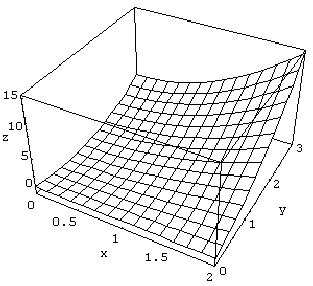 a) Find
the equation of the plane tangent to the surface at the point (1,2).
a) Find
the equation of the plane tangent to the surface at the point (1,2).
1. Given the surface f(x,y) = x2y+y2-2y
 a) Find
the equation of the plane tangent to the surface at the point (1,2).
a) Find
the equation of the plane tangent to the surface at the point (1,2).
z=4(x-1)+3(y-2)+2
b) Find the volume of the solid under f in the region R = {(x,y)| 0x2, 0y3}.
Volume = 12 cubic units.
2. Continuing with the function f(x,y) = x2y+y2-2y from problem 1,
a) What is the directional derivative of f in the direction of the vector <1,2>?
Du = ![]()
b) In which direction does f increase most rapidly?
The direction of the gradient, i.e. <4,3>.
3. Compute ![]() ,
where C is the top half of a circle of radius 2 centered at the origin
and oriented counterclockwise.
,
where C is the top half of a circle of radius 2 centered at the origin
and oriented counterclockwise.
It comes out to -8.
4. Find a quadratic approximation for the function f(x,y) = x2
cos
y near the point (1,![]() ).
).
P2(x,y) = ![]() .
.
5. Calculate ![]() where S is the top half of a sphere of radius 3 along with the disc
of radius three (centered at the origin) in the xy-plane.
where S is the top half of a sphere of radius 3 along with the disc
of radius three (centered at the origin) in the xy-plane.
It comes out to ![]() .
.
6. The mythical blue polar bunnies of Antarctica live secretly on a
peninsula shaped like the portion of the curve x = 16 - y2 which
lies to the right of the y-axis. If the bunnies' population density is
given by the function ![]() = 50 + 8y + 10x, what is the total bunny population of the peninsula?
= 50 + 8y + 10x, what is the total bunny population of the peninsula?
9728 happy little mythical blue polar bunnies.
7. Let D be a region with area A bounded by a simple closed path C in the xy-plane. Use Green's Theorem to prove that the coordinates of the center of mass of the region are

8. Buffy says "Like, Oh my God, my calc final was like, so hard. There was this one problem that was, like, about level curves, you know? And it was like, not even a formula, you know? They just told you, like, some stuff, and you were, you know, s'posed to say what the surface-thingy would be like? Like, for one of them, it said that the level curves were, like, circles, and they were all, like, concentric around the origin. And it said, if one surface with level curves like that had 'em so they got more and more spaced out as you got away from the origin, but another surface had 'em so they got closer and closer together as you got away from the origin, then, like, what are the two surfaces like? Oh my God, I just had no clue at all!"
Give Buffy some clue about what the information she tried to describe would tell us about the two surfaces. Obviously, she needs things explained very clearly.
There's of course no one right answer, but the
general idea is that the surfaces with such level curves could be something
funnel-like (consider the picture on p. 776 in Stewart) and a paraboloid,
respectively. It was important, though, not to say that these were the
only
possibilities, since the same level curves (when they aren't labeled with
heights) can exist for different surfaces, e.g. consider graph F on p.
769 of Stewart and imagine variations on graph B from that same page. I
was generally satisfied with something coherent about two surfaces matching
Buffy's description along with some indication that people understood that
the relation between functions and their level curves has some important
caveats.
9. Consider functions of the form f(x,y) = x2 + bxy + y2, where b is any constant. For which values of b is (0,0) a local minimum? A local maximum? A saddle point?
If |b|<2 the origin is a local minimum.
If |b|>2 the origin is a saddle point.
No value of b produces a local maximum.
(I kicked in an extra point to people who rounded
things out by adding that b=2 gives a parabolic cylinder, which you can
see if you factor the resulting function and think a bit.)
10. Consider the hyperboloid x2 + y2 - z2 = 1. Find the volume enclosed by the hyperboloid and the planes z = -c and z = c.
Volume = ![]() .
.
Extra Credit (5 points possible):
Look back at the very first problem. Is there some point (a,b) for which
the volume under the tangent plane (on the region R) is equal to the volume
under f (on R)? Find the point(s), or explain why they can't exist.